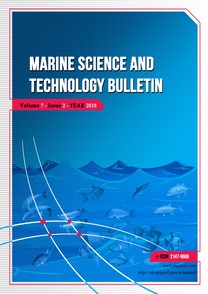Mapping and Recording of Ancient Shipwrecks by Using Marine Remote Sensing Techniques: Case Studies From Turkish Coasts
Ancient shipwrecks, Remotely operated vehicle, Side-scan sonar, Sub-bottom profiler, Underwater cultural heritage Underwater photogrammetry,
___
- Ballard, R. D., Lawrence, E., Stager, D. M., Yoerger, D., Mindell, D., Whitcomb, L. L., Singh, H., & Piechota, D. (2002). Iron Age shipwrecks in deep water off Ashkelon, Israel. American Journal of Archaeology, 106(2), 151–168.
- Bass, G. F. (Ed.) (2005). Beneath the seven seas: Adventures with the Institute of Nautical Archaeology. Thames & Hudson.
- Bates, C. R., Lawrence, M., Dean, M., & Robertson, P. (2011). Geophysical methods for wreck-site monitoring: The rapid archaeological site surveying and evaluation (RASSE) programme. International Journal of Nautical Archaeology, 40(2), 404-416. https://doi.org/10.1111/j.1095-9270.2010.00298.x
- Bingeman, J. N., Bethel, J. P., Goodwin, P., & Mack, A. T. (2000). Copper and other sheathing in the Royal Navy. International Journal of Nautical Archaeology, 29(2), 218-229. https://doi.org/10.1111/j.1095-9270.2000.tb01453.x
- Bingham, B., Foley, B., Singh, H., Camilli, R., DellaPorta, K., Eustice, R., Mallios, A., Mindell, D., Roman, C., & Sakellariou, D. (2010). Robotic tools for deep water archaeology: Surveying an ancient shipwreck with an autonomous underwater vehicle. Journal of Field Robotics, 27(6), 702–711. https://doi.org/10.1002/rob.20350
- Boersma, J., Yntema, D., & van der Werff, J. (1986). Excavations in the House of the Porch (V. ii. 4–5) at Ostia. BABESCH - Annual Papers on Mediterranean Archaeology, 61, 77-138. https://doi.org/10.2143/BAB.61.0.2012598
- Brennan, M. L., Ballard, R. D., Roman, C., Bell, K. L., Buxton, B., Coleman, D. F.,Inglis, G., Köyğasıoğlu, O., & Turanlı, T. (2012). Evaluation of the modern submarine landscape off southwestern Turkey through the documentation of ancient shipwreck sites. Continental Shelf Research, 43, 55-70. https://doi.org/10.1016/j.csr.2012.04.017
- Delaporta, K., Jasinski, M. E., & Søreide, F. (2006). The Greek‐Norwegian deep‐water archaeological survey. International Journal of Nautical Archaeology, 35(1), 79-87. https://doi.org/10.1111/j.1095-9270.2006.00090.x
- Drap, P., Merad, D., Hijazi, B., Gaoua, L., Nawaf, M. M., Saccone, M., Chemisky, B., Seinturier, J., Sourisseau, J. -C., Gambin, T., & Castro, F. (2015). Underwater photogrammetry and object modeling: A case study of Xlendi Wreck in Malta. Sensors, 15(12), 30351-30384. https://doi.org/10.3390/s151229802
- Kızıldağ, N., & Özdaş, H. (2021). Relative sea‐level changes along the Fethiye coast (SW Turkey) based on recent archaeological data. Geoarchaeology, 36(3), 474-489. https://doi.org/10.1002/gea.21841
- Lurton, X. (2010). An introduction to underwater acoustics: Principles and applications. Springer Science & Business Media.
- Opait, A. (2004). The eastern Mediterranean amphorae in the province of Scythia, pp. 293–308. In: Eiring, J., & Lund, J. (Eds.), Transport amphorae and trade in the eastern Mediterranean: Acts of the international colloquium at the Danish Institute at Athens. Aarhus University Press.
- Özdaş, H. (2009). Ege Bölgesi sualtı araştırması 2007 yılı çalışmaları. Araştırma Sonuçları Toplantısı, 26, 249-258.
- Özdaş, H. (2010). Ege-Akdeniz Bölgesi sualtı araştırması 2008 yılı çalışmaları. Araştırma Sonuçları Toplantısı, 27, 433-452.
- Özdaş, H. (2022). Karaburun Roma Dönemi Rodos Batığı: Ön inceleme sonuçları [Karaburun Roman Period Rhodian Shipwreck: Preliminary results]. Türk Arkeoloji ve Etnografya Dergisi, 83, 11-31.
- Özdaş, H., Kızıldağ, N., & Okan, E. (2012). Ege-Akdeniz bölgesi sualtı araştırması 2010 yılı çalışmaları. Araştırma Sonuçları Toplantısı, 29, 267-280.
- Pacheco-Ruiz, R., Adams, J., Pedrotti, F., Grant, M., Holmlund, J., & Bailey, C. (2019). Deep sea archaeological survey in the Black Sea–Robotic documentation of 2,500 years of human seafaring. Deep Sea Research Part I: Oceanographic Research Papers, 152, 103087. https://doi.org/10.1016/j.dsr.2019.103087
- Prummel, W. (2003). Animal remains from the Hellenistic town of New Halos in the Almirós plain, Thessaly. In: Kotjabopoulou, E., Hamilakis, Y., Halstead, P., Gamble, C., & Elefanti, P. (Eds.), Zooarchaeology in Greece: Recent advances (pp. 153-159). British School at Athens.
- Pulak, C. (1998). 1996 Sualtı araştırması. Araştırma Sonuçları Toplantısı, 15(1), 307–322.
- Quinn, R. (2006). The role of scour in shipwreck site formation processes and the preservation of wreck-associated scour signatures in the sedimentary record – evidence from seabed and sub-surface data. Journal of Archaeological Science, 33(10), 1419-1432. https://doi.org/10.1016/j.jas.2006.01.011
- Quinn, R., Breen, C., Forsythe, W., Barton, K., Rooney, S., & O’Hara, D. (2002). Integrated geophysical surveys of the French Frigate La Surveillante (1797), Bantry Bay, Co. Cork, Ireland. Journal of Archaeological Science, 29(4), 413-422. https://doi.org/10.1006/jasc.2002.0732
- Royal, J. (2006). The 2005 remote-sensing survey of the south-eastern Bozburun Peninsula, Turkey: Shipwreck discoveries and their analyses. International Journal of Nautical Archaeology, 35(2), 195–217. https://doi.org/10.1111/j.1095-9270.2006.00112.x
- Singh, H., Adams, J., Mindell, D., & Foley, B. (2000). Imaging underwater for archaeology. Journal of Field Archaeology, 27(3), 319-328. https://doi.org/10.2307/530446
- UNESCO. (2001). Convention on the Protection of the Underwater Cultural Heritage 2001. Retrieved on March 2022, from http://portal.unesco.org/en/ev.php-URL_ID=13520&URL_DO=DO_TOPIC&URL_SECTION=201.html
- Ward, C., & Ballard, R. D. (2004). Deep-water archaeological survey in the Black Sea: 2000 season. International Journal of Nautical Archaeology, 33(1), 2-13. https://doi.org/10.1111/j.1095-9270.2004.00002.x
- Westley, K., Plets, R., Quinn, R., McGonigle, C., Sacchetti, F., Dale, M., McNeary, R., & Clements, A. (2019). Optimising protocols for high-definition imaging of historic shipwrecks using multibeam echosounder. Archaeological and Anthropological Sciences, 11(7), 3629-3645. https://doi.org/10.1007/s12520-019-00831-6
- Zorlu, T. (2008). Innovation and Empire in Turkey: Sultan Selim III and the modernisation of the Ottoman navy. IB Tauris Academic Studies.
- ISSN: 2147-9666
- Yayın Aralığı: 4
- Başlangıç: 2012
- Yayıncı: Adem Yavuz SÖNMEZ
Joyanta BİR, Md Rony GOLDER, Shikder Saiful ISLAM
Md. Abdul AL MOHİT, Md. TOWHIDUZZAMAN, Atish KUMAR JOARDAR, Mossa Samima NASRİN, Mst. Rabiba KHATUN
Ayşegül Feray MEYDAN, Suna AKKOL, Onur Hakan DOĞAN
Sudhan CHANDRAN, Sanjenbam Bidyasagar SINGH, Giri Bhavan SREEKANTH, Geetanjali DESHMUKHE, Binay Bhusan NAYAK, Ashok Kumar JAISWAR
Aslı Şükriye ŞALCIOĞLU, Adem Yavuz SÖNMEZ
